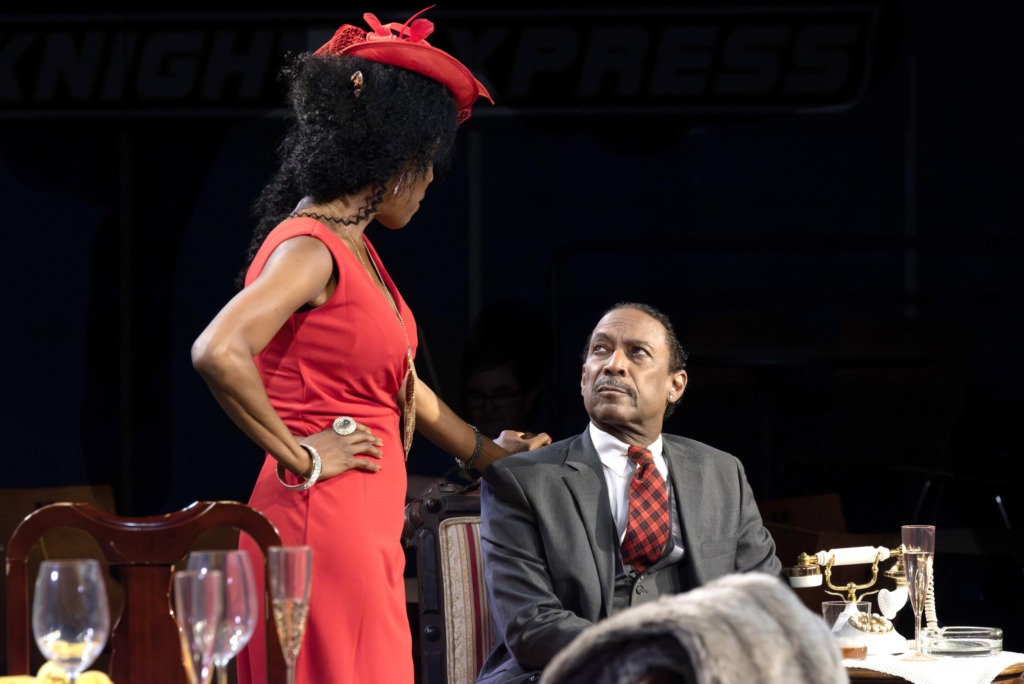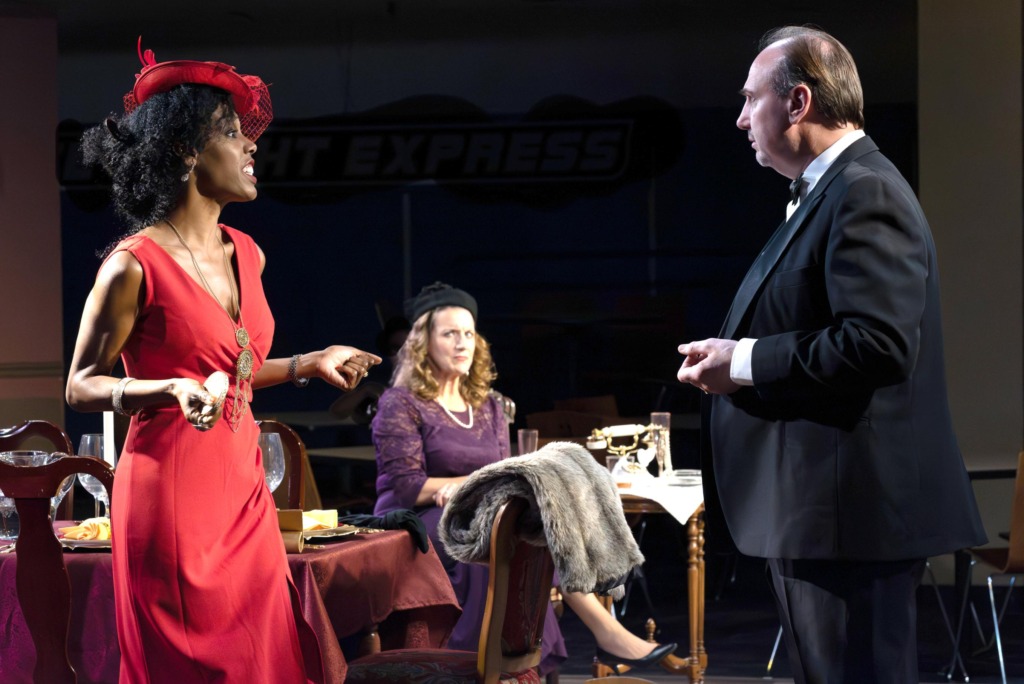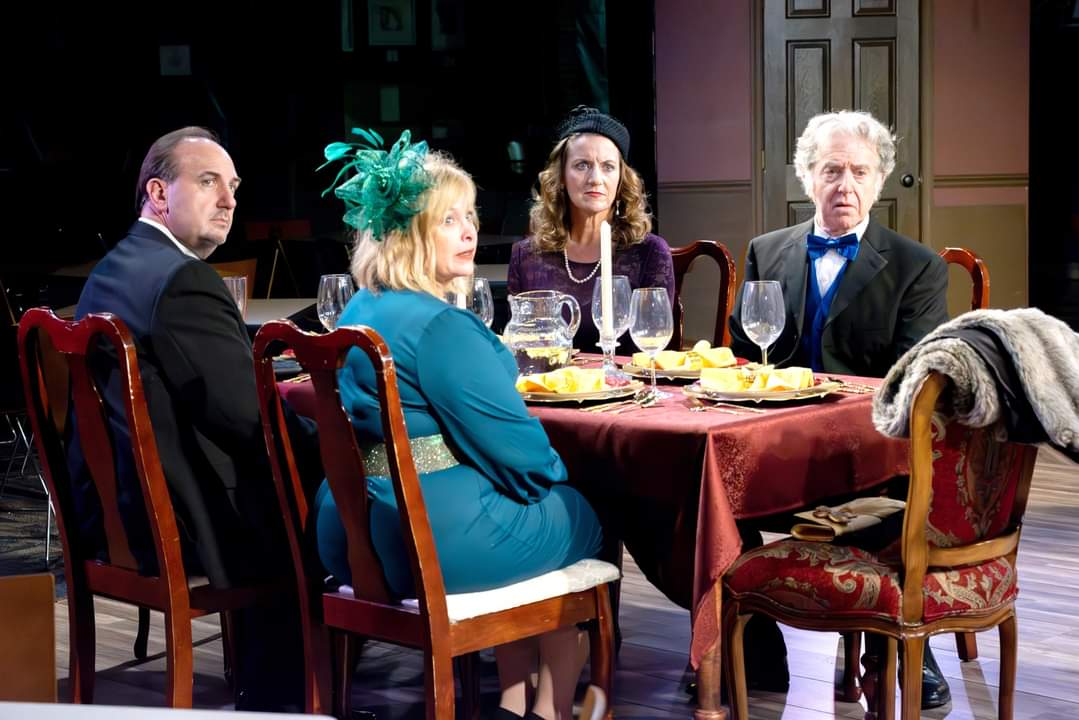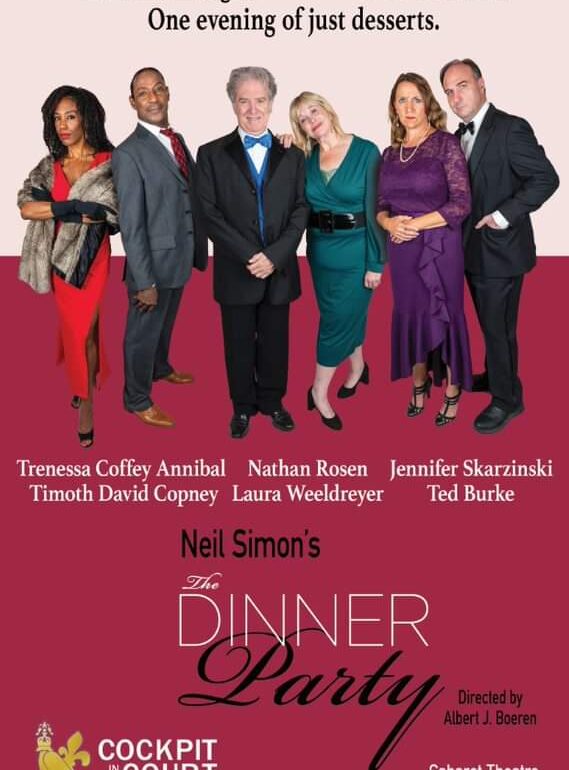There are no surprises in life, only corroborations of what you suspected. Well, someone must have called Ezekiel Foster up in lighting and told him to hit me with ‘surprise pink’ when I showed up for The Dinner Party thinking it was one of Neil Simon’s shorter works that would run about 90 minutes without an intermission. Cockpit In Court, for reasons known only to them, have splashed an intermission right in the center of the production and expounded upon the show’s run-time to the tune of a little over two hours. Despite the dated piece, the show itself is quite funny, though at points torturous in its plot (and that’s 100% the fault of the late Neil Simon…what most say in ten words or less he takes no fewer than 100…) but all-in-all it’s a quirky little evening that clearly starts out at a farcical level but— surprisingly— does not achieve high-absurdity. Directed by Albert J. Boeren, this questionable comedy will certainly give you moments of laughter and a great deal to mull over, especially if you’re ever to consider accepting an unsolicited invitation to a dinner party!

While Cockpit in Court’s main stage is a traditional proscenium, the upstairs cabaret joint is— well, the student-union-cafeteria. But that doesn’t stop Scenic Designer G. Maurice “Moe” Conn III from doing a pretty impressive job with laying out a swanky Parisian restaurant with an ambiguously modern-ish flare. (We’ll get to the squeaky, sticky floor in a moment.) Conn’s work— because the stage isn’t even a traditional in-the-square, but rather a ‘postage stamp with windmill-arms extending from its corned points to make an ‘x’— is minimal yet tasteful. Assisted by Scenic Artist Angela J. Boeren and Properties Manager Lisa L. Boeren, Conn’s set displays a convincing, intimate dining room complete with subtle splashes of artwork and décor. (It’s the musical cues of Parisian-sounding elevator tunes that clue you in to the fact that it’s meant to be in Paris. That and all the French names of the characters.) The one set where the set— and I won’t say fails, as its not like the set collapsed beneath the actors— but where the set… let’s say… detracts from the physical stage traffic of the play is with the ‘parquet’ flooring. While it looks nice, something has happened in the process of its being affixed to the low-rise stage, making it intolerably squeaky and ‘sticky’-sounding. Every time an actor moved about the space, regardless how light of foot, you could hear the floor ‘giving way’ beneath their steps, like the ‘parquet’ look hadn’t been glued down properly or like whatever was underneath of it for support was giving way. It also made that sticking-sound like you expected an actor’s shoe to get stuck and while this didn’t ruin the show, it was distracting enough to note, particularly in the more intense, emotional-driven moments where formerly married couples were squaring off with each other (only two performers on stage) and the intensity of their argument or dialogue exchange was sucked right out of the room by the constant squeak-stick-squawk of the floor.
Where the show sparkles is with Eva Grove’s Costume compilation. Six actors, six costumes, and they’re all perfectly colorful, really showcasing the intent of attending a dinner party for the evening. There’s even a radiant burst of glitter-sparkle (that must have drifted up through the floorboards from the downstairs production of The Prom) in one of the accent belts on one of the ladies’ dresses. Grove finds two ‘black-tie’ affair style suits, making both the Claude and Albert characters look like penguin-butlers, with a cheap-shine to the one featured on Albert, which lends itself to the repeating joke of the fact that his character rented the suit for the evening. And there are splashy, shiny accessories for the three female characters— furs, fascinators, even a drippy lavalier for Gabrielle, which just ties her whole ensemble together. Grove brings an air of mystique to the production with these posh pieces, lending an aristocratic flare to the production’s overall aesthetic.
Whatever the reason (one suspects that the theatre wants to sell concessions and give its dominating demographic a restroom break), The Dinner Party at Cockpit in Court finds itself with an intermission splashed in the middle of it. Neil Simon wrote the play without one. Director Albert J. Boeren has managed to pick a superb place to stick the break— and if you didn’t know that the play wasn’t supposed to have one, you wouldn’t know that it was Boeren who chose that exact moment to place it because it feels natural. That said, there is a jarring disruption in the show’s overall momentum that never quite recovers in the second act, and I suspect that’s a combination of Neil Simon’s lengthy wording needing to be pushed at top-speed from start to finish without a pause. Boeren molds his cast to fit the caricature types Simon has written— six mostly unredeemable rather milquetoast, sketches of the upper class that most of just can’t don’t or won’t relate to. To quote Sondheim at Simon, “They’re not good, they’re not bad, they’re just nice.” Though honestly, there’s nothing nice about these characters either. But they aren’t despicable a la every single character that populates Succession. Which makes it really difficult to care about or invest in their narrative.
But— but it’s a comedy, so don’t we just show up, laugh until our sides hurt, and leave feeling entertained? That’s the vein in which Albert J. Boeren has pushed the show, and graciously so, because Simon’s work (yes, yes, great American playwright and all that— not every play can be a winner) is rather like Winter’s Tale, it’s not a deep drama or a high-comedy, it’s a problem play where the last 20 minutes is Neil Simon holding the audience hostage with a series of lackluster confessions that nobody needs to hear. Fortunately for the audiences at Cockpit In Court, Albert J. Boeren manages to really highlight the moments of intense comedy, which is almost enough to carry the audience through that really awkward ending. The show’s pacing isn’t as tight as it could be; there are definitely moments— particularly in the one-on-one exchanges between the ex-couples where the delivery could be quicker, more argumentative, and tighter. But the pacing and Simon’s overall narrative aside, there are a lot of really great laughable moments that keep you engaged with what’s happening on the stage.

With just six performers on stage, the audience finds itself with the opportunity to pay close attention to all the details— the way the walk or stand, the facial expressions they make when they think no one is looking, if they fidget, etc. Fortunately for audiences at Cockpit In Court, these six performers appear very invested in their character portrayal and even if the words don’t come spilling out at lightning speed, they seem to definitely understand the humor of the piece, particularly the fellas, as their characters are imbued with the comic zips, zaps, and zingers. Claude (Ted Burke), Albert (Nathan Rosen), Andre (Timoth David Copney), Mariette (Jennifer Skarzinski), Yvonne (Laura Weeldreyer), and Gabrielle (Trenessa Coffey Annibal) make up the six. And in Neil Simon’s The Dinner Party it’s a veritable La Cage Aux Folles in the “just who is who and what is what is quite the question” sense.
You get some very amusing antics out of the physicality of Albert (Nathan Rosen) particularly in the ‘one-way-conversation’ scene shared with Yvonne (Laura Weeldreyer.) While Weeldreyer’s character does a lot of talking… or pleading and fussing, take your pick… Rosen is doing a great deal of body-language forward responsive acting, which is actually quite hilarious…especially as at any one time half of the audience or more is presented with only a view of his back and yet you can still see exactly what sort of response he’s giving! That’s an impressive feat. Rosen plays up the dim-witted and befuddled nature of the character…it’s like Albert has a permanent smudge. On his brain. It’s hard to put your finger on it, but whatever it is, Rosen does it well. Weeldreyer’s character gets presented as a nervous, indecisive individual, right up until she starts verbal-vomiting all of her— everything— all over Rosen’s Albert. The pair have a perfectly perfunctory chemistry, which is exactly what you’d expect from a couple who has been married and divorced. Twice.
Mariette (Jennifer Skarzinski) shows up in a ruffle of frustration and is often caught taking nonsense to the comedic extremes. Skarzinski imbues the character with a temper, which at times starts and peaks right at a ten, though this is easily overlookable given how sharp her comic timing is. Pitted opposite Ted Burke’s Claude, you find that Skarzinski’s boisterous nature is a nice change of pace to the rote doldrums Burke is bringing to the table. Burke lives up to the accusations slung at his character of being somewhat of a robot, almost existing like a pre-programed robo-animatronic butler that only has spark when he engages with Skarzinski’s Mariette. The pair fit the bill for all of the awkward that keeps popping up throughout the play, though if there’s one critique to truly be had with either of them it’s that in moments of extreme emotional outburst— like when Skarzinski goes to whomp Burke with her gold jacket— she backs off and shies away. If you’re going to be so furious as to need to throttle someone with your accessories, don’t be afraid to go there fully.

Mismatched love forged in the fires of hell is how best to describe Andre (Timoth David Copney) And Gabrielle (Trenessa Coffey Annibal.) Copney is serving up a hot and spicy platter of acerbic wit, zipping one-liners, hard-punches, and clever zingers all throughout the first act. His comic timing is flawless, though this does little to make the character of Andre any more redeemable than the rest of them. Annibal bursts onto the scene at the very end of the first act, in a surprise shock of fire-engine red, accessories for miles, and a fascinator that could slay. Though the text her character is given is a ludicrous mismatch with what’s actually happening in her portrayal, she’s fun to watch. The Gabrielle character, in Annibal’s portrayal, becomes Satan’s Pekingese— perky, bouncy, and yappy yet full of the vim and vigor of mischief and hellfire. The outfit is full-on Elizabeth Hurley a la Bedazzled (2000) and so is her confident strut, but never once does anything remotely seductive come out of her mouth. It’s baffling but truly wild. The way Annibal and Copney play off one another is arguably the most intriguing dynamic of the three featured couples, with Copney presenting a banal ‘humane’ side to his otherwise milquetoast character. (Again these characters are lackluster and middle-of-the-road thanks to Neil Simon…you get what you get when you pick a Neil Simon script.)
It’s a tad on the long-winded side, a tad on the needs-to-move-more-expediently side, but it’s got a lot of good comedic moments and truly laugh-worthy one-liners that help make up for its faults as a production overall. Get out your finest cocktail dress and be sure to purchase some snacks in the lobby as the auditorium has ‘dining tables’ for your convenience. And get your tickets to see Cockpit in Court’s The Dinner Party in production through the first weekend in August.
Running Time: 2 hours and 20 minutes with one intermission
The Dinner Party plays through August 6th 2023 at Cockpit in Court in the upstairs Cabaret Space of The Robert and Eleanor Romadka College Center at the Community College of Baltimore County Essex Campus— 7201 Rossville Boulevard, Essex MD. For tickets call the box office at (443) 840-2787 or purchase them online.

